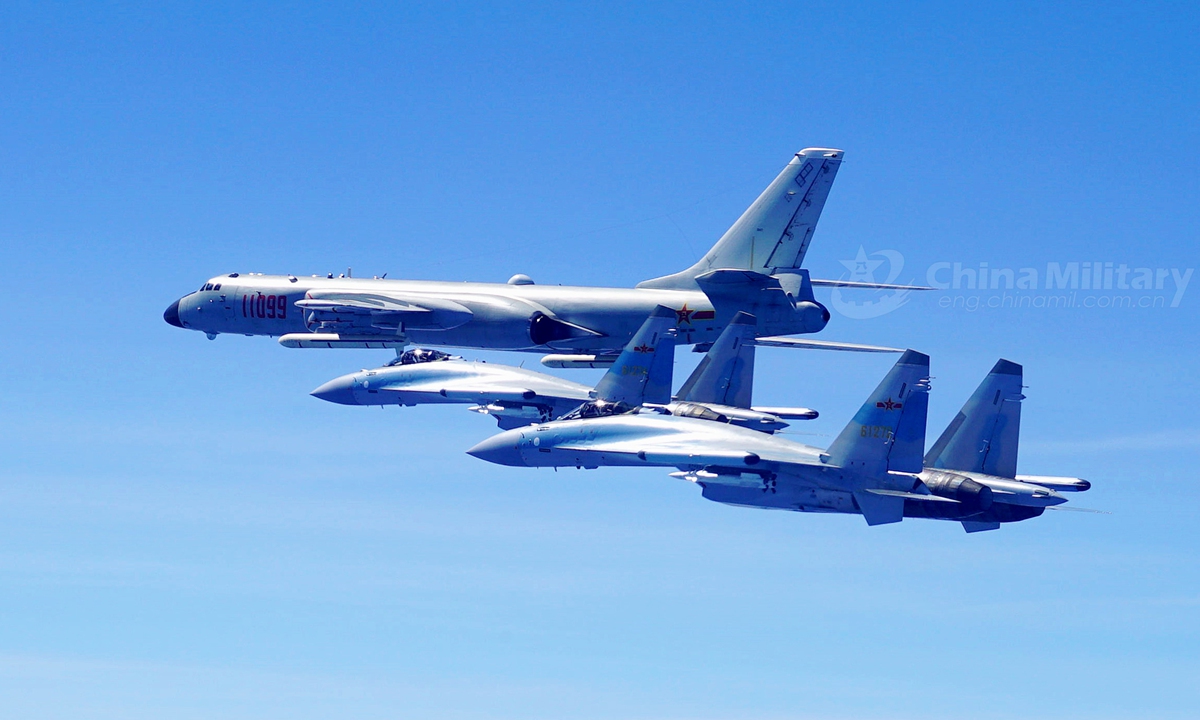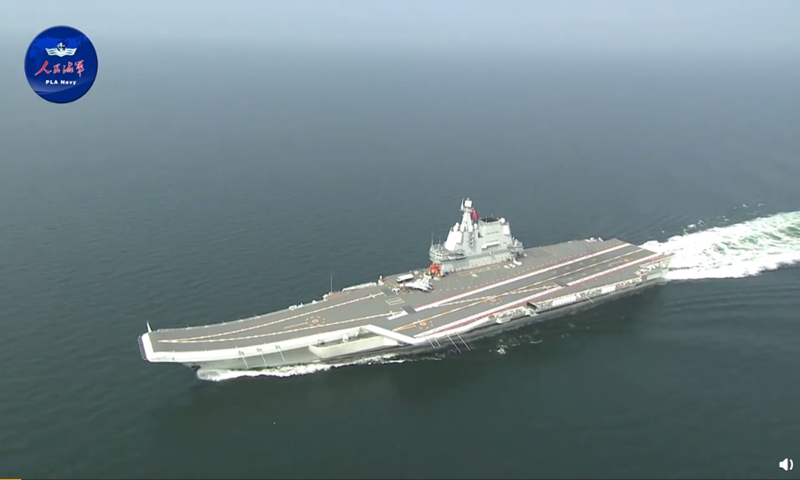'Simulated enemy' helps PLA drill for real combat capability
By Yang Sheng Source: Global Times Published: 2020/8/17 21:38:40 Last Updated: 2020/8/17 22:38:40
Frequent presence of US warplanes no big deal: military experts

Two Su-35 fighter jets and a H-6K bomber fly in formation on May 11, 2018. The People's Liberation Army (PLA) air force conducted patrol training over China's island of Taiwan on Friday. Su-35 fighter jets flew over the Bashi Channel in formation with the H-6Ks for the first time, which marks a new breakthrough in island patrol patterns, said Shen Jinke, spokesperson for the PLA air force.Photo:China Military
US forces are increasing intelligence gathering of the military deployment of the People's Liberation Army (PLA) around potential battlefields, Chinese mainland military experts said on Monday, after Taiwan media reported a US B-1B bomber flied near the island on Sunday. Experts said that the Chinese military should also be prepared for a potential conflict.
US warplanes' frequent presence in the East and South China seas are adding uncertainty and danger in the region, but it doesn't mean the current situation could turn into another Taiwan Straits crisis as in 1995-96, because the US has no advantage in the region, and the Trump administration is incapable of planning a major military conflict with China, experts said.
The US bomber's presence has encouraged some Taiwan separatists, as pro-separatism media Liberty Times reported on Monday that the bomber took off from Andersen Air Force Base in Guam and approached the southern part of the East China Sea Air Defense Identification Zone (ADIZ) of China on Sunday, an area to the northeast of Taiwan island. The media claimed that such a move "challenges the bottom line of the PLA."
However, mainland military experts didn't see such activities as a major threat. Xu Guangyu, a senior adviser to the China Arms Control and Disarmament Association, told the Global Times on Monday that "US forces have sent their bombers and electronic intelligence aircraft near our ADIZ and South China Sea more than 1,000 times in the past two years. The activities show that the US wants to keep tensions high in the region. But this poses no major threat to us."
"They didn't enter our territorial airspace, so we don't need to shoot them down, and most of the warplanes sent by the US are surveillance aircraft that don't carry weapons. This shows that the US also wants to be restrained and avoid sparking unnecessary conflict," Xu said.
Song Zhongping, a Chinese mainland military expert, told the Global Times on Monday that "the PLA should remain vigilant, as the US is trying to collect intelligence on the mainland's military deployment, as well as around the region by increasing reconnaissance missions near China."
Increasing reconnaissance missions is what the US normally does before a massive military operation, so the PLA needs to follow its own plan to prepare for a potential conflict, especially with the US, once the US crosses the bottom line, Song stressed.

China's second aircraft carrier sails through the Taiwan Straits into the South China Sea in November 2019. Photo: screenshot from the Weibo account of the PLA Navy
Another Taiwan Straits crisis?
The frequent presence of US warplanes and corresponding military drills by the PLA in the region have increased fears of a war between the mainland and Taiwan, as well as US forces, or tensions similar to the Third Taiwan Straits crisis in 1995-96.
In that crisis, the US sent two aircraft carrier strike groups to the Taiwan Straits, and the mainland conducted live-fire ballistic missile drills near the island. Chinese mainland experts said the current situation is unlikely to escalate into another crisis, because the balance of power between the mainland and Taiwan, as well as with the US, has changed.
Xu said, so far, the US dares not to send its aircraft carriers to the Taiwan Straits, and only sent warplanes, since they know the aircraft carrier is slow and easy to spot, while warplanes are more flexible and can leave the region immediately. "The US knows it can't threaten China as it did in the 1990s."
In 1990s, the PLA didn't have enough power to effectively destroy the US fleets, so the US dared to intervene. But now, the PLA Navy's combat capability can even block the eastern side of Taiwan island, and its ballistic missiles can easily destroy US military bases and naval ports in the Western Pacific, Song said.
"This is why the mainland is becoming more confident and determined to defend its core interests and sovereignty despite US military presence in the region," he noted.
More and more Chinese observers are worried that the Trump administration could use Taiwan to provoke China ahead of the US presidential election. But Xu said Trump's team is suffering from domestic pressures and lacks strategic vision, so they are unable to make a massive military plan to confront a country like China.
"Chinese military forces are keeping their eye on US bases in the Western Pacific. As long as the aircraft carriers strike groups and US Marines' amphibious assault ships aren't sent out, we don't need to be overly anxious," Xu said.
On electronic intelligence aircraft and bombers from US bases, Xu said that "they provide opportunities for PLA radar forces, air force and navy to train for electronic warfare. Having the US Air Force serve as a 'simulated enemy' in a drill helps the PLA prepare for actual combat."
The Taiwan authority also ordered their fighter pilots not to fire the first shot without instructions from the island's "air force combatant command." Otherwise, they will be punished, Taiwan media chinatimes.com reported on Monday.
Posted in: HK/MACAO/TAIWAN